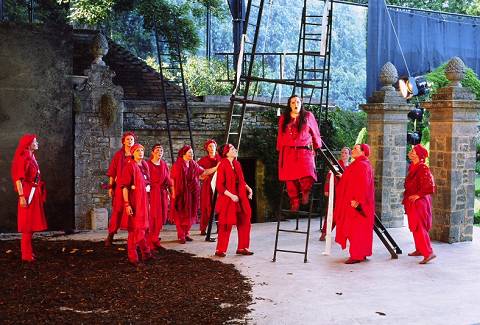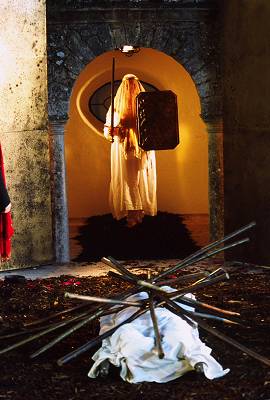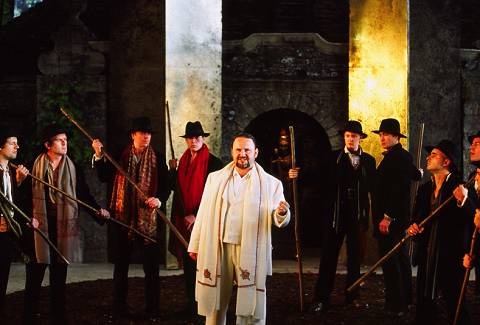|
<< -- 4 -- Roderic Dunnett FEMALE INSURGENCE

Wyn Pencarreg, an emerging young baritone with a memorable performance
as the Count in Figaro (for Mid Wales Opera) among his scalps, brought
some authority though not quite sufficient tone (he has it, in ladles) outdoors
to the ruler-by-marriage, Premysl, who has succeeded the dead Libuse (to
whom he owed his throne). The feel of a nebulous mediæval court felt
more vitally captured than in Garsington's Genoveva a few seasons
back : here, with the ceremonial processions, you got the feeling Ingrams's
team could almost carry off a Tannhauser.

A state in turmoil : the arrival of Sárka (Susan Stacey) and her female warriors
in Act 1 of Garsington Opera's 2002 production of 'Sárka'. Photo: Keith Saunders
|
The women's music (for the red-clad Bacchante followers of the rebellious
Sárka, swarming over the Garsington roof tiles uttering their woes
-- "beda"s -- with inevitable shades of Frankie Howerd) ranges
closer to Foerster or Fibich; the oboe, for her forbidden lover Ctirad's
prayer (the effectively idiomatic Slovak tenor Ludovit Ludha), again suggests
quite late Janácek. Susan Stacey delivered her Sárka ('Vlasta's
warrior') in a suitably forceful and cutting voice. The woodland music,
and the orchestra's subsequent soft doubling of Ctirad's declaration of
love, was particularly affecting.

A sword-bearing Sárka (Susan Stacey in the title role) emerges from the tomb of Queen Libuse in Act 3 of Janacek's 'Sárka'.
Photo: Keith Saunders
|
Sárka needs a good chorus, and got it -- both the female
ranting and the male chorus's noble devotion, led by a fine solo choregus
and some remarkably pleasing tenors, as they build the funeral pyre for
the dead hero which prefaces Sárka's self-immolation : a popular
theme in Czech opera and melodrama, from Vanda (Dvorák) and
Hippodameia (Fibich) to Eva (Foerster), with obvious mainstream
precedents in Norma and Brünnhilde. Skilled lighting by Bruno Poet
helped make this entombment scene -- led by the noble intoning of Premysl
and Lumir (Lorenzo Carola) and brought alive by the sibyl-like epiphany
of Sárka, looking like the dead Libuse, bearing the symbolic sword
of Trut -- both impressive and involving.

Ludovit Ludha (Ctirad) in Garsington Opera's production of 'Sárka'.
Photo: Keith Saunders
|
Amid this ritual offering, with the doomed lovers Ctirad and Sárka
cast as a kind of Adonis-cum-Persephone, everyone seems to have come to
their senses : reconciliation is in the air, as the women's adoption of
men's black, and the men's of the women's red, symbolises. The final chorus
was stupendous. Statuesque opera this may be, but there is a dramatic genre
here (Smetana's Libuse and Liszt's occasionally staged Legend
of St Elizabeth fall within the category); and in its own way, this
was not a bad example of it.
Continue >>
Copyright © 4 October 2002
Roderic Dunnett, Coventry, UK

|

